How to Check Spark Plugs (9 Conditions to Look For)
Though gasoline engines vary, all share spark plugs for igniting fuel. These plugs periodically need service. A good plug takes battery current to the coil, sparking combustion in the cylinder. With failing plugs, you’ll experience rough idling, poor acceleration, and other issues.
This article provides step-by-step instructions on removing your spark plugs to check their condition and the tools you’ll need. You can compare how your plugs look to 9 different conditions to reveal not only if they work, but how well, avoiding guesswork troubleshooting.
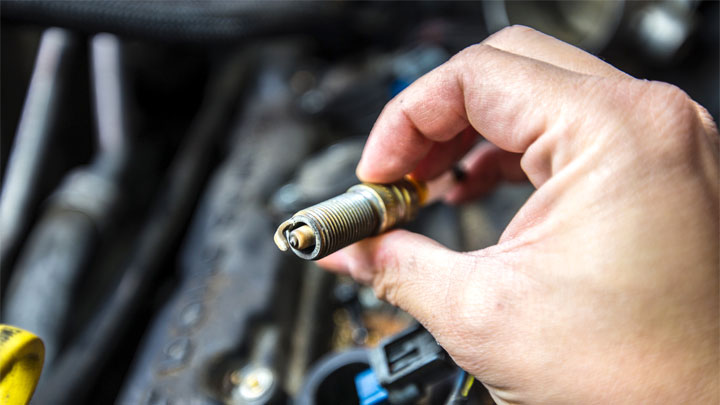
Related: How to Change Spark Plugs (Beginner Friendly)
Spark Plug Removal
Tools Required
As with any automobile maintenance job, having certain tools at hand will make life easier for you. For spark plug removal and reinstallation, the following basic set of hand tools and consumables are required:
- 3/8″ drive ratchet
- 3/8″ drive universal joint
- 3/8″ drive extensions (3″, 6″, and 10″)
- Spark plug boot removal tool (required for older engines)
- Spark plug gap gauge
- 3/8″ drive torque wrench (10 to 80 ft-lbs.)
- 3/8″ drive spark plug socket (one of the below sizes):
- 13/16″ (or 20 mm) for most full-size cars.
- 9/16″ (or 14 mm) for Ford and newer Asian cars.
- 11/16″ (or 18 mm) for older BMW cars.
- 14 mm bi-hex for newer BMW cars.
- (See Also: Spark Plug Socket Sizes Chart)
- Tube of silicone dielectric grease
- Shop manual for your specific vehicle
To gain access to the spark plugs, you will need the following additional hand tools:
- 3/8″ drive socket set
- Combination wrench set (includes sizes from 3/8″ (10mm) up to 1/2″ (13mm))
- Screwdriver set
- Channellock pliers (small)
- Shop vacuum with a slender crevice tool (to clean around spark plug holes)
Note that if you drive a Ford with certain Triton engines, your spark plugs may actually remove themselves.
How to Remove Spark Plugs to Check Their Condition
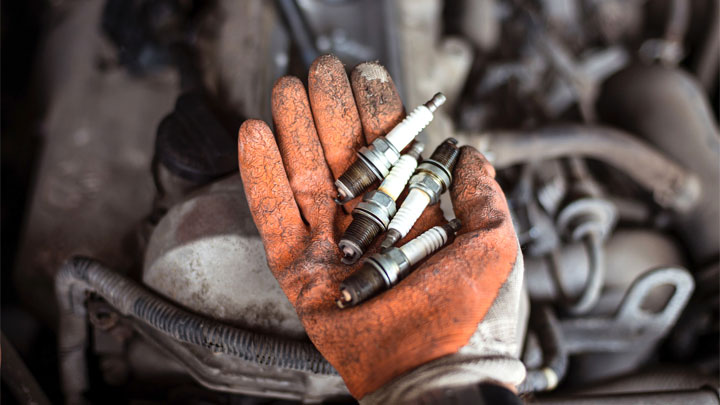
Spark plugs are relatively simple to remove. Getting access to them can be the major stumbling block. This can be especially true if the engine in your car is a cross-mounted V6. For V6 engines, the plugs nearest the driver can often be the most aggravating to work on.
- Open the hood. Place an old but clean bath towel over each fender to minimize risk of your belt buckle scratching the paint. Now assess the engine arrangement. Determine the best way to get to the spark plugs. Remove any cover(s) and/or insulating panels that prevent access to the plugs.
- Items like wiring harnesses, hoses and electrical modules that block access to the plugs will have to be removed (or moved aside) to gain access to the area directly above each plug.
- In most modern cars, each spark plug will have an electronic module (the spark coil) above each of the plugs. For older cars, a single large diameter wire will go to the top of each spark plug. In this case, no coils will be present.
Also some coils fit in only one specific location. Observe how the coils are positioned so you can replace them properly. Sometimes taking a picture or two with your smartphone will be helpful to get parts properly reinstalled.
- If there is a spark coil above every spark plug, these will have to be removed. Each coil will have a low voltage cable attached to a connector. This cable should be disconnected.
- Study this connector. It will probably have a snap latch that will have to be moved or pressed to release it. Often these latches are made of a contrasting color. Using a screwdriver, release this latch. Pull the connector off the coil housing.
- Remove the fastener that holds the coil in place and pull the coil out from the spark plug.
- If there is no spark coil above each plug, use the boot removal tool to pull the spark plug boot straight off the plug. Always grip the boot as near to its base as possible. Wiggling the boot gently while pulling will help it come free. Never pull off a boot by gripping its associated spark plug wire.
- Using the appropriate size socket, extension, and universal joint if necessary, remove the spark plug. Make a note or tag for each plug so you will know what cylinder each came from. If the spark plug hole is accessible, wipe the flat or tapered seat in the cylinder head with a clean cloth. With your Shopvac (or household vac), use the crevice nozzle to suck dirt away from this area.
Note: Use caution to avoid dropping small parts or dirt down the spark plug hole. Even a small screw dropped into the combustion chamber could result in severe engine damage.

Spark Plug Conditions and Colors
Living at the top of the combustion chamber, each spark plug will be affected and marked by whatever is happening there. So inspecting each plug can reveal much about how your engine is running.
Here’s where knowing which cylinder each plug came from can be helpful. You may later need to advise your service technician which cylinder has a problem.
#1 – Normal Condition
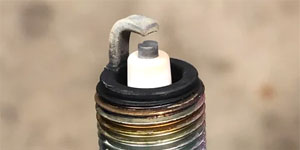 Insulator around the center electrode is grayish-white or grayish-yellow to brown. Side electrode is clean. This tells us that combustion processes are normal.
Insulator around the center electrode is grayish-white or grayish-yellow to brown. Side electrode is clean. This tells us that combustion processes are normal.
There may be some very light oil burn but nothing to worry about. Your engine is running well.
#2 – Sooted/Carbon Fouled
 Plug surfaces uniformly coated with dull black deposits.
Plug surfaces uniformly coated with dull black deposits.
Cause: Engine running rich (too much fuel); dirty air filter; engine startup fuel-air mixture control not operating properly; excessive short-distance driving; improper spark plug.
#3 – Oil Fouled
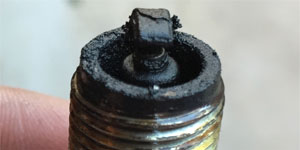 Plug parts have a wet or shiny black coating.
Plug parts have a wet or shiny black coating.
Cause: Excess oil in combustion chamber due to: Oil level too high; crankcase venting system not operating properly, piston rings and/or valve stem seals badly worn or broken.
See Also: 6 Causes of Oil on Spark Plug Threads
#4 – Lead Fouling
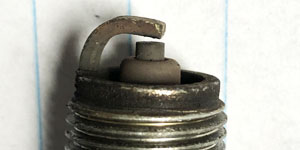 Plug parts coated with brownish-yellow glazing which may include a greenish tinge. Glazing may be thin or thick and/or partially chipped off.
Plug parts coated with brownish-yellow glazing which may include a greenish tinge. Glazing may be thin or thick and/or partially chipped off.
Cause: Use of leaded fuel (not generally available in the USA) or use of fuel additives containing lead.
#5 – Ash Fouling
 Plug parts coated with light-colored thick ceramic-like compound. Brittle. May be chipped off with fingernail or jackknife.
Plug parts coated with light-colored thick ceramic-like compound. Brittle. May be chipped off with fingernail or jackknife.
Cause: Excessive use of fuel and/or oil additives.
#6 – Center or Side Electrode Eroded/Melted Away
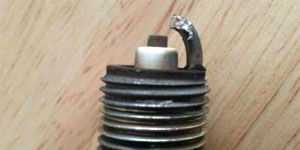 Center insulator may also be blistered or soft.
Center insulator may also be blistered or soft.
Cause: Overheating of the plug and combustion chamber due to poor quality fuel (octane rating too low); ignition timing over advanced; pre-ignition; engine running lean; improper spark plug.
#7 – Heavy Wear of Center Electrode
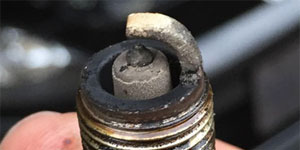 Electrode partially or completely worn away.
Electrode partially or completely worn away.
Cause: Spark plug has exceeded its service life; plug gap too large; improper spark plug.
#8 – Heavy Wear on Side Electrode
 Electrode partially or completely worn away.
Electrode partially or completely worn away.
Cause: Poor quality fuel (octane rating too low); pre-ignition; excessive use of fuel and/or oil additives.
#9 – Center Electrode Insulator Nose Fractured
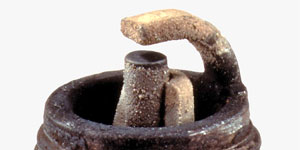 Small piece of insulator missing.
Small piece of insulator missing.
Cause: Mechanical damage (plug was dropped); excessive deposits alongside center electrode; plug has exceeded its service life.
- Old spark plugs cannot be successfully cleaned. At a minimum, the plug conditions indicated in 2 through 9 above will necessitate installing new plugs.
- Plug conditions evident in 2, 3, 6 and 8 should encourage further evaluation of the engine, fuel, and ignition systems by a qualified service technician for corrective action.
Installing New Spark Plugs
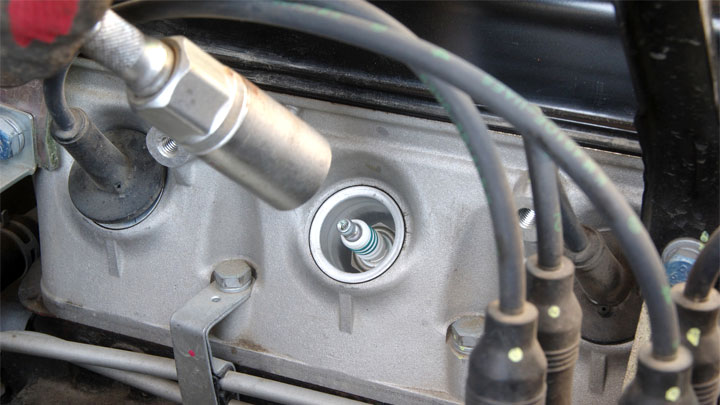
- Unpackage your new spark plugs. In general, spark plugs come from the manufacturer with the proper gap. However, it is wise to check that gap before installing them. Gap dimensions can be found in your shop manual.
- Using the gap tool, check the gap between the center and side electrode. Spark plugs with multiple side electrodes (two or more) will have a factory set gap and need not be checked.
- Using the bending tab on the gap tool, slightly bend the side electrode to attain the proper gap. Do not over-bend the electrode. One very slight change in gap should be all that is needed. Check and properly set the gap for each plug.
- Push a new plug firmly into the spark plug socket. Guide the socket and plug down to the threaded spark plug hole. This may be easier to do with an extension on the socket.
- Now by hand turn the socket clockwise (CW) to screw the plug into the hole. The spark plug should screw in easily. If it does not it may be cross-threaded. In this case, do not force it, but remove and realign it. Then retry tightening it by hand. Screw the plug all the way in.
- Find the spark plug tightening torque value in your shop manual. If your torque wrench is adjustable, set it to this value. Tighten the plug with the torque wrench.
- Apply a light coating of dielectric grease to the inside diameter of the spark plug boot. Firmly press the plug wire or coil boot onto each spark plug. Reinstall the power connector to each spark coil.
- Repeat Steps 2 through 4 for each spark plug.
- Reinstall any parts earlier removed to gain access to the plugs. Reposition wiring harnesses, hoses and/or modules that were temporarily moved aside for access. Make sure that no wires or hoses now come into contact with hot surfaces like the exhaust manifolds.
- The plugs are now installed. You can start the engine. It should start and run smoothly.
Why Modern Day Spark Plugs Last So Long
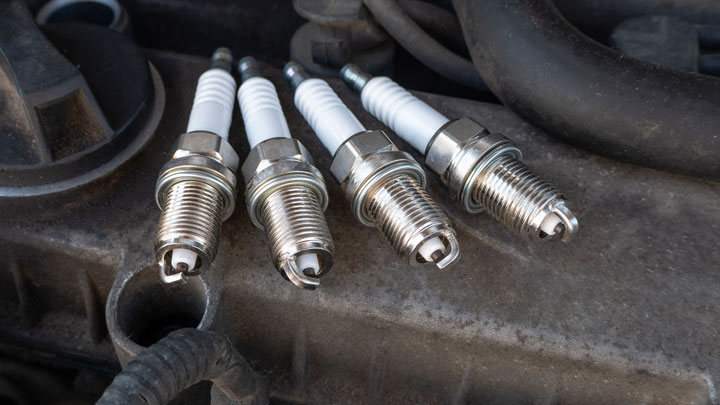
As already mentioned, the role of the spark plug is to ignite the fuel-air mixture in each of your engine’s cylinders. Modern plugs perform this role admirably. Not long ago, spark plugs had to be replaced every 10,000 to 12,000 miles.
Today the plugs can go as long as 100,000 miles with no need for service. What’s changed?
#1 – Fuel Injection
First, automobile and truck engines today are fuel-injected. Thus fuel-air mixtures are well-controlled by the computerized Engine Control Module (ECM). We know that excessively high temperatures are a major enemy of spark plugs. But well-controlled fuel-air mixtures enable more consistent combustion at lower temperatures than was possible in engines years back.
#2 – Unleaded Gas
Second, the elimination of lead from domestic gasoline has also contributed to longer plug life. When leaded fuels were prevalent, lead deposits on the spark plug tips invited corrosion of the plugs and hindered proper spark action thus adversely affecting their operation.
#3 – Better Materials
Third, we find today’s spark plugs are made of far more durable materials than those of earlier years. The electrical current carrying component (specifically the center electrode) of today’s plugs is often made of costly platinum, iridium or copper.
These advanced materials ensure that plug anodes do not burn away as quickly and will carry electrical current more efficiently than older spark plug designs. The most common types of spark plugs using these advanced materials and their benefits are discussed here.
To help get the best life and performance out of your engine, purchasing the best quality spark plugs is strongly recommended. And that includes achieving the manufacturer’s recommended mileage for plug replacement.
- DIY Car Repair Tools – Floor Jack and Jack Stands - Dec 12, 2023
- DIY Car Repair Tools – Socket (Ratchet) Wrench - Nov 9, 2023
- DIY Car Repair Tools – Torque Wrench - Apr 20, 2023

Looking for best performing and long lasting spark plugs for my toyota premio 240.
Thanks. I just changed mine in my Audi last weekend. This video came just in time too and I didn’t use anti-seize either